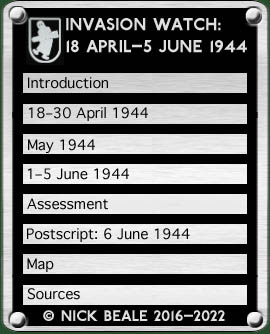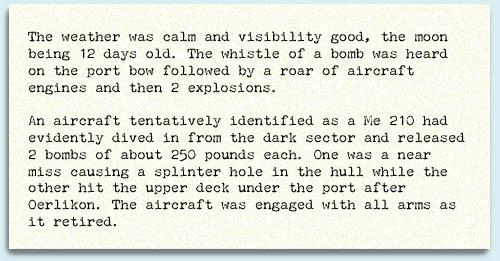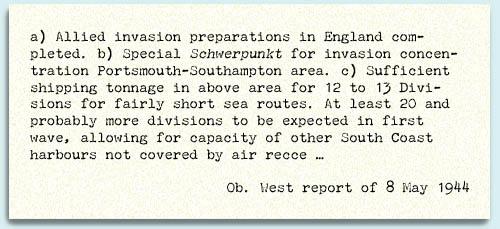|
4 May Traffic was heard from an Aufkl.Gr. Ob.d.L. aircraft, T9+LH, from 0116 and it was homing on Orly three quarters of an hour later. During this period the destroyer HMS Offa, in position 30 km SW of St. Catherine’s Point, was superficially damaged by bombs. The ship was soon able to resume her patrol but three ratings had been killed and four others left seriously injured.
While there was no intelligence as to who might have done this, it was noted that five Me 410 of II./KG 51 had been put up against Allied raids over Northern France. Operational Watch reviewed what they knew: There is no satisfactory explanation for this bomb; a British a/c jettisoning its load has been suggested as a possibility. The time would fit with the time of landing of T9+LH, but there is no other circumstance to couple the two events. The possibility cannot be ruled out that this was some kind of experimental attack, possibly using a newly introduced ASV device of some kind (in view of the nature of the unit involved). The 1.(F)/121 gave up Me 410 A-3, W.Nr. 170008 to München-Riem for the repair of crash damage. 5–6 May No German activity was reported on the 5th and just two aircraft from Morlaix on security reconnaissance 80 km south of Start Point the day after. There was however a later German signal about three airmen (Uffz. Koch, Gefr. Schraber and Gefr. Muck) who had failed to return from a flight over enemy territory, apparently on 5 May, while on attachment to Wekusta 51. In its diary for 5 May, the Seekriegsleitung recorded recent intelligence: Re the Invasion: statements of captured crew members from the destroyer sunk in the Channel offer no indication of an imminent initiation of action. According to the report of a well-regarded agent, about 800,000 GRT of shipping is assembled in the Bristol Channel. 150,000 GRT and a large number of smaller ships are reported from Plymouth; from Exeter/Exmouth, 50,000 GRT. Sufficient shipping capacity for an invasion will not be ready before 15 May. 7 May In the Western and Central Channel sorties were dispatched in the evening and morning respectively but none approached closer than 65 km to the English coast. The 5.(F)/123 however sent two Bf 109 out from St. Pol at 0945 GMT to photograph Dover and Deal, one of which obtained photos from 8000 m in the 10 minutes from 1045. The other machine had been forced to abort when its cabin iced up at 7000 m. Six small naval units were seen off Dover but nothing in the Thames Estuary. 8 May
Supplementary: according to aerial photos, on 8.5 Falmouth was heavily occupied by landing vessels, including 17 LST, 4 LSI, about 100 landing craft, 2 troop transporters, 2 tankers and numerous small vessels. Fremde Heere West The days’ efforts suggest a renewed sense of purpose with the following photographic sorties mounted, albeit with scant success: One Bf 109 up at 0434 GMT for Portsmouth – Cowes area: broke off at 0515 at 11,000 m owing to fighter defence. This aircraft was heard landing in the Cherbourg area at 0532. Two Bf 109 up from Dinard at 0531 for Plymouth: broke off at 0611, about 48 km south of Rame Head, due to engine damage. One Bf 109 up 0752 for Deal – Dover: broke off at 0755, 5 km south of Ramsgate with engine trouble. Two Bf 109 from Dinard at 1115 for the St. Austell – Falmouth area: reported only three eastbound destroyers, apparently in Mounts Bay. The third of these missions reported a total of seven small vessels at sea but no shipping established in Deal or Dover harbours (in point of fact, Deal has no harbour). The Kriegsmarine received a preliminary interpretation of the day’s photographic coverage of Falmouth. Present were a large number of small warships, four LSI, 14 LST, 16 large and 38 small landing boats, two transports, a freighter and 19 coastal vessels. This represented a considerable increase over the occupancy on 27 April. A Bf 109 G-6, W.Nr. 160869, of Stab NAG 13 incurred 55% damage when it crashed at Dinard; it may well have been the one on the second of the above operations which suffered engine trouble. 9 May During the day, NAG 13 achieved no fewer than 12 sorties over the western part of the Channel from Dinard and Morlaix. None of them appears to have crossed the English coast although the two airborne at 1830 did cover Lyme Bay before heading home. From Bernay, two Bf 109 of 4.(F)/123 took off at 0858 GMT to photograph Exmouth and Torquay but turned back when they found 9/10 cloud over the target area; they did however spot westbound convoys of eight and six vessels before returning over the Cherbourg Peninsula. At 0745 GMT, during an operational flight, a Bf 109 G-8 of 1./NAG 13 (W.Nr. 20679, white 7) suffered a broken oil pipe and force-landed on heathland 20 km of Lessay, on the western side of the Cherbourg Peninsula. Leutnant Schwantje was unhurt but the landing damaged the Messerschmitt’s airscrew and starboard wing and it was consigned to the workshops at Conches-en-Ouche. This too was the destination of the Staffel’s Bf 109 G-6, W.Nr. 161117, which had been 10% damaged that day (see 18 May, below).
continued on next page …
|
|||



